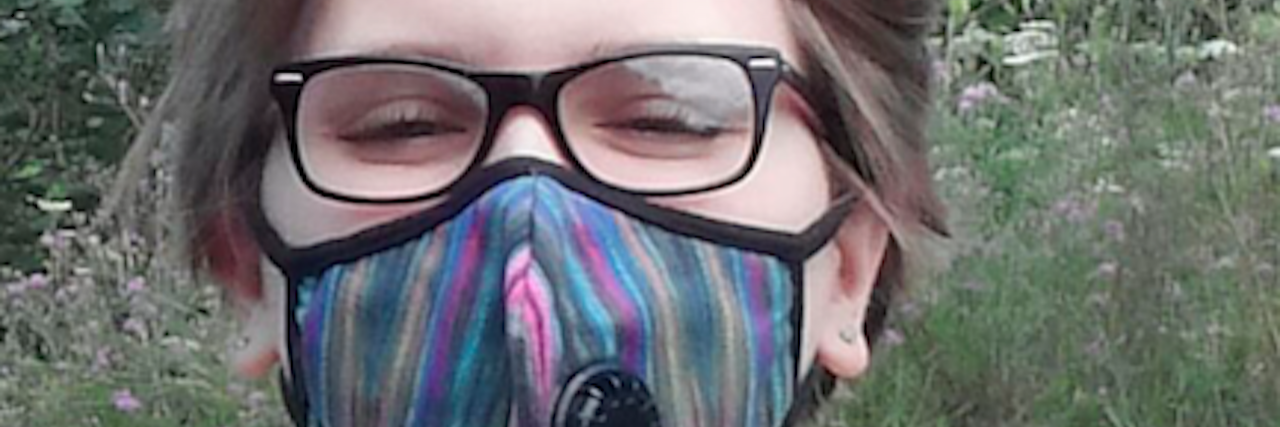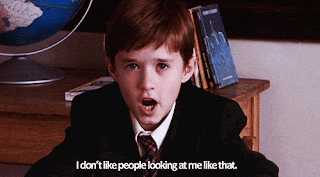As my two friends and I stroll through the mall on a hot summer day, one of them asks, “What if I stared at other people like there was something wrong with them?”
You may need some more information in this situation. The three of us don’t exactly look like a “normal” group of teenagers. My one friend is pushing me in my wheelchair carrying my backpack, which holds my tube feedings, IV nutrition and drain bag. I have braces on my knees and a mask on my face.
You could say I stand out a bit.
You’d think people would use their common sense and not look at me like i’m some robot-alien out of a sci-fi movie, but most people ignore their common sense and stare. The amount of people who stare at me on a daily basis used to bother me, and it still does sometimes. But now, I ignore it and stare right back at them. Or I identify and organize them into categories for my entertainment. Now, these stares I get aren’t just the occasional “I think I’m being discreet and innocent glancing” stare. More often, they’re the “blatantly obvious, straight on, what is that?!?” stare.
There are so many different types of stares used in different places and in different situations, so lets take a look at a few of the most common ones.
1. The “I think I’m being discreet and innocent, glancing” stare.
Ah, one of the classics. You’re all guilty of it. This stare occurs when an individual, let’s refer to them as person A, spots another individual, person B, who, for various reasons, stands out from society’s “normal” appearance. Person A tries to fulfill their curiosity in a way they believe is appropriate by slightly rotating their head by a few degrees at a time when they think person B is not looking. Then, they move their head slowly back to its original position when thought to be socially acceptable. This process is often repeated multiple times until person B has left person A’s line of sight.
Here’s a little secret from somebody who is often person B in this situation: I can see you staring at me. When there are 20 people in a room all trying to perform the “I think I’m being discreet and innocent glancing” stare, it’s likely that more than one person will be looking at me at one time.
2. The “Blatantly obvious, straight on, what is that???” stare.
The most common misconception about this stare is that it is mostly done by children. I’ve found this stare is actually most commonly executed by grown men and women who I’m sure have acquired the proper social skills to know not to do this but do it anyway. Stare #2 usually happens when person A swiftly detects diversity on their radar and decides to ignore their instinct to be polite. Person A then rotates their head, and sometimes even their entire body, and fixes their point of origin on person B. Person A may continue the stare anywhere from 30 seconds to minutes.
Stare #2 can be the most angering (and the most amusing) of them all — for me, anyway. I find it so ridiculous that people stare like this that I can’t help but want to go hand them a brochure entitled “Manners for the Common Idiot” and walk away like Beyoncé.
3. The “Oh my gosh, I feel so bad for you” stare.
Sigh. My experience is that Person A in this situation is often a teenage girl, couples with young children or an elderly person, but usually a teenage girl. Accompanied by a look of pity, this stare happens when person A is overcome with emotion after seeing someone they believe needs to be pitied. Person A then proceeds to stare, maybe tilts their head slightly and continues to feel bad for me until something new and maybe shiny catches their eye. Just thinking about this stare makes me want to puke. Person A in this situation is probably the type of person who is guilty of using people with disabilities as objects of inspiration.
4. The “What is that, whats wrong with them?!!?” stare.
With a mix of curiosity and horror, person A stares without trying to hide their emotions. This stare is a more obvious one and may end with person A whispering to the people around them, causing a ripple effect of many types of stares. I really don’t appreciate this stare, but I do enjoy watching people trying to figure out what is wrong with me. I get this stare the most when I’m at the beach and people are trying to figure out what the tubes coming out of me are. It’s great.
Thinking back to that day in the mall, most of the people we passed by are guilty of staring. I understand people don’t always know how to react when they see someone different from themselves, but it’s not polite to stare. Ever. I joke about this because it’s not going to stop anytime soon and I’d rather laugh than cry about it, but it needs to change. People need to realize that when you stare, other people also stare to try and figure out what the first person was staring at. Then, it’s like I have bright red letters painted on my back reading, “PLEASE STARE AT ME.” Soon, the whole room is looking at me. It’s not OK to stare at someone of a different race, age, height or weight than you, so why would it be OK to stare at someone with a disability or illness who looks different than you? Nobody should feel self-conscious about how they look, whether they have a disability or not.
So here’s a tip for everyone out there who is guilty of staring: Just don’t do it. Ever.
Follow this journey on Climbing Rivers.
The Mighty is asking the following: “Staring” is a topic that comes up so much in our community. Tell us about one unforgettable “staring” experience you or someone you love had that’s related to disability, disease or illness. If you’d like to participate, please send a blog post to community@themighty.com. Check out our Share Your Story page for more about our submission guidelines.



